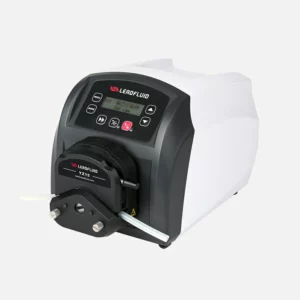The speed of a peristaltic pump refers to the rotational speed of the rotor or roller mechanism, which directly affects the flow rate and performance of the pump. The pump speed is an adjustable parameter that can be set according to the specific requirements of the application.
Here are some key aspects related to the use of peristaltic pump speed:
- Flow Rate Control: The pump speed is a crucial factor in controlling the flow rate of the peristaltic pump. By adjusting the speed, you can increase or decrease the rate at which the fluid is pumped through the tubing. Higher speeds generally result in higher flow rates, while lower speeds reduce the flow rate.
- Dosing Accuracy: The pump speed plays a significant role in achieving accurate dosing or metering of fluids. Fine-tuning the speed allows for precise control over the volume of fluid dispensed per unit of time. This is particularly important in applications that require precise dosing, such as pharmaceutical manufacturing or chemical process control.
- System Compatibility: The pump speed needs to be set within the operating range recommended by the pump manufacturer. Exceeding the recommended speed limits may cause excessive wear on the tubing, reduced pump life, or compromised accuracy. It’s important to consult the pump’s specifications and user manual to determine the suitable speed range.
- Fluid Properties: The speed of the peristaltic pump can also be influenced by the properties of the fluid being pumped. For example, fluids with higher viscosity may require slower speeds to ensure proper flow and prevent excessive tubing deformation. Additionally, fluids with high particulate content may require slower speeds to avoid clogging or blockages.
- Pump Longevity: Operating the peristaltic pump at excessively high speeds for extended periods can lead to premature wear and decreased pump life. It is recommended to use the pump within the specified speed range and consider the application requirements and fluid characteristics when setting the speed.
- Calibration and Calibration Curves: Some peristaltic pumps may require calibration to establish a relationship between the pump speed and the actual flow rate delivered. Calibration curves or tables can be generated to ensure accurate flow rate control across different pump speeds.
In summary, the speed of a peristaltic pump is a critical parameter that directly affects the flow rate, dosing accuracy, peristaltic pump speed and overall performance of the pump. By adjusting the speed within the recommended range and considering the fluid properties, you can achieve precise and controlled fluid metering or pumping for various applications.
When it comes to more information on using and controlling the speed of peristaltic pumps,.
Here are some points to add:
- Liquid characteristics and viscosity: The characteristics and viscosity of the liquid have an impact on the choice of peristaltic pump speed. Higher viscosity liquids usually require a lower pump speed to ensure fluidity and avoid excessive deformation. For liquids with high particle content, a lower pump speed helps prevent clogging or blockage.
- Traffic requirements: Determine the required traffic range based on application requirements. The speed of the peristaltic pump should be selected to meet the needs of fluid delivery while maintaining accurate flow control. A higher pump speed can provide a higher flow rate, while a lower pump speed will reduce flow rate.
- Response time: For applications that require a fast response, a higher pump speed may be more appropriate. Faster pump speeds provide faster flow rate changes and reduce system response time.
- System pressure: The choice of peristaltic pump speed should take into account the required system pressure. Higher pump speeds can produce higher pressures, but it is necessary to ensure the pressure resistance of the pump and line when operating under high pressure.
- Automation and control: Many peristaltic pumps have automation and remote control functions. Through interfaces or controllers, pump speeds can be adjusted and monitored for precise flow control and integration with other systems.
- Stability and oscillation: When choosing the speed of the peristaltic pump, it is necessary to pay attention to the stability and oscillation of the system. Too high a pump speed may cause the system to oscillate or lose control of the fluid, while too low a pump speed may affect the stability and flow uniformity of the system.
- Verification and calibration: To ensure the accuracy and performance of the peristaltic pump, verification and calibration are recommended. Through the actual test, the relationship between the pump speed and the actual flow rate can be established and calibrated as needed.
In short, peristaltic pump speed is an important parameter that has a direct impact on flow control, application requirements and system performance. When selecting the pump speed, factors such as liquid characteristics, flow requirements, system pressure and stability should be considered, and reasonable Settings and controls should be carried out in combination with the specifications and application requirements of the peristaltic pump.
